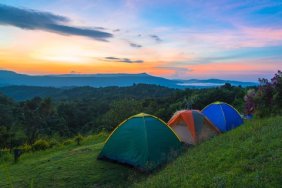 While I strongly insist that every outdoors enthusiast keep a reliable compass handy whenever they venture out into the wilderness, some would agree that they are limited in their navigational capacities. Technology has advanced a lot since hiking’s trail-blazing beginnings, and products have been invented throughout the years that, through streamlining and providing peace of mind, have made the outdoors more enjoyable. Such products include clothing made from fabric created to provide comfort and function, backpacks made from lightweight and highly durable components, and handheld GPS units.
While I strongly insist that every outdoors enthusiast keep a reliable compass handy whenever they venture out into the wilderness, some would agree that they are limited in their navigational capacities. Technology has advanced a lot since hiking’s trail-blazing beginnings, and products have been invented throughout the years that, through streamlining and providing peace of mind, have made the outdoors more enjoyable. Such products include clothing made from fabric created to provide comfort and function, backpacks made from lightweight and highly durable components, and handheld GPS units.
Since their introduction to the outdoors market, handheld GPS units made by companies like Magellan or Garmin have evolved from straightforward GPS units, and current models now possess features such as emergency locator beacons, route and waypoint display, and built-in digital cameras. The devices themselves are small enough to fit inside your pocket, or be clipped to a backpack strap. To find the best one for your needs, there are several factors that must be taken into consideration.
I would advise choosing a system that can store several routes, first and foremost. Also, a system that’s capable of keeping track of 100 or more waypoints is a plus. When considering satellite tracking, a unit that has multi-parallel channels. This means that instead of being connected to just one satellite, you’ll be tracked by several, which makes emergency situations easier to handle. Durability, waterproof design, long battery life, and a nice backlit display screen are also features to look for.
Really, the most important thing you can do when picking up a GPS unit is gain knowledge and familiarity with it. Ask the associate about different models, have them show you how to use it, and then practice using the unit in the store. Read the manual carefully and make the GPS your new best friend before even heading out to a hike. The last thing you want to find yourself in is huddled in the dark, trying to read the GPS manual because you can’t figure something out.
There are several models from which to choose when shopping for a GPS to suit your travelling needs. As I said previously, some of the features are more of a bonus (camera, for example), but others are integral in certain circumstances. Really take the time to consider what characteristics you’ll need and correlate those needs with your price range. Any knowledgeable sales associate will be able to help you narrow your options down to one or two units, based on your requirements. Once you find one that works for you, learn how to use it and head out to the trail with the peace of mind of having a reliable navigator on hand. Just be sure to bring extra batteries, because even the most advanced GPS needs batteries to function.








